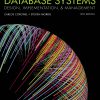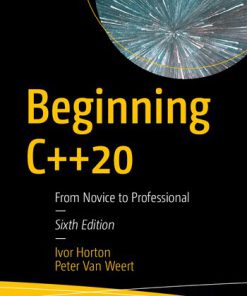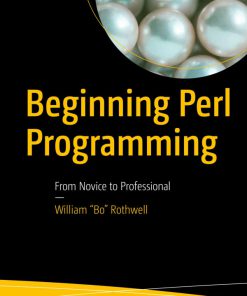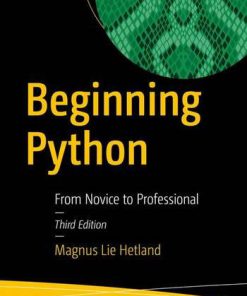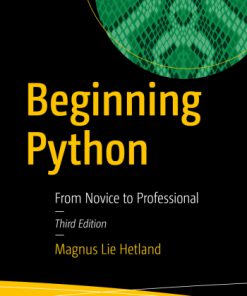Beginning SQL Queries From Novice to Professional 2nd edition by Clare Churcher 1484219553 9781484219553
$50.00 Original price was: $50.00.$25.00Current price is: $25.00.
Beginning SQL Queries From Novice to Professional 2nd edition by Clare Churcher – Ebook PDF Instant Download/DeliveryISBN: 1484219553, 9781484219553
Full download Beginning SQL Queries From Novice to Professional 2nd edition after payment.
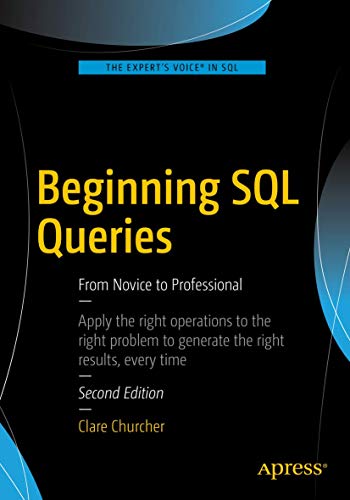
Product details:
ISBN-10 : 1484219553
ISBN-13 : 9781484219553
Author: Clare Churcher
Clare Churchers Beginning SQL Queries is your guide to mastering the lingua franca of the database industry: the SQL language. Good knowledge of SQL is crucial to anyone working with databases, because it is with SQL that you retrieve data, manipulate data, and generate business results. Knowing how to write good queries is the foundation for all work done in SQL, and it is a foundation that Clare lays well in her book. Does not bore with syntax! Helps you learn the underlying concepts involved in querying a database, and from there the syntax is easy Provides exceptionally clear examples and explanations Is academically sound while being practical and approachable
Beginning SQL Queries From Novice to Professional 2nd table of contents:
Chapter 1: Relational Database Overview
Introducing Database Tables
Attributes
The Primary Key
Inserting and Updating Rows in a Table
Designing Appropriate Tables
Introducing Data Models
Retrieving Information from a Database
Process Approach
Outcome Approach
Why We Consider Two Approaches
Summary
Chapter 2: Simple Queries on One Table
Subsets of Rows and Columns
Using Aliases
Saving Queries
Specifying Conditions for Selecting Rows
Comparison Operators
Logical Operators
Dealing with Nulls
Finding Nulls
Comparisons Involving Null Values
Managing Duplicates
Ordering Output
Performing Simple Counts
Avoiding Common Mistakes
Incorrectly Using a WHERE Clause to Answer Questions with the Word “both”
Incorrectly Using a WHERE Clause to Answer Questions with the Word “not”
Summary
Chapter 3: A First Look at Joins
The Process Approach to Joins
Cartesian Product
Inner Join
Outcome Approach to Joins
Extending Join Queries
A Process Approach
Order of Operations
An Outcome Approach
Expressing Joins Through Diagrammatic Interfaces
Other Types of Joins
Outer Joins
Summary
Chapter 4: Subqueries
IN Keyword
Using IN with Subqueries
Being Careful with NOT and
EXISTS Keyword
Different Types of Subqueries
Inner Queries Returning a Single Value
Inner Queries Returning a Set of Values
Inner Queries Checking for Existence
Using Subqueries for Updating
Summary
Examples of Different Types of Subqueries
A subquery returning a single value
A subquery returning a set of single values
A subquery checking for existence
Examples of Different Uses for Subqueries
Constructing queries with negatives
Comparing values with the results of aggregates
Update data
Chapter 5: Self Joins
Self Relationships
Creating a Self Join
Queries Involving a Self Join
What Are the Names of the Coaches?
Who Is Being Coached by Someone with a Higher Handicap?
List the Names of All Members and the Names of Their Coaches
Who Coaches the Coaches, or Who Is My Grandmother?
An Outcome Approach to Self Joins
Questions Involving “Both”
An Outcome Approach to Questions Involving “Both”
A Process Approach to Questions Involving “Both”
Summary
Self Relationships
Questions Involving the Word “Both”
Chapter 6: Multiple Relationships Between Tables
Two Relationships Between the Same Tables
Extracting Information from Multiple Relationships
Process Approach
Outcome Approach
Business Rules
Summary
Chapter 7: Set Operations
Overview of Basic Set Operations
Union-Compatible Tables
Ensuring Union Compatibility
Union
Selecting the Appropriate Columns
Uses of Union
Union and Full Outer Joins
Intersection
Uses of Intersection
The Importance of Projecting Appropriate Columns
Managing Without the INTERSECT Keyword
Difference
Uses of Difference
Managing Without the EXCEPT Keyword
Division
Projecting Appropriate Columns
SQL for Division
Summary
Union
Intersection
Difference
Division
Chapter 8: Aggregate Operations
Simple Aggregate Functions
The COUNT() Function
Managing Nulls
Managing Duplicates
The AVG() Function
Managing Nulls
Managing Duplicates
Managing Types and Output
The ROUND() Function
Other Aggregate Functions
Grouping
Filtering the Result of an Aggregate Query
Using Aggregates to Perform Division Operations
Nested Queries and Aggregates
Summary
Chapter 9: Window Functions
Simple Aggregates
Partitions
Order By Clause
Cumulative Aggregates
Ranking
Combining Ordering with Partitions
Framing
Summary
OVER()
OVER(PARTITION BY )
OVER(ORDER BY )
OVER(PARTITION BY ORDER BY )
OVER(ROWS BETWEEN AND )
Chapter 10: Efficiency Considerations
What Happens to a Query
Finding a Record
Storing Records in Order
Clustered Index
Non-Clustered Indexes
Clustered Index on a Compound Key
Updating Indexes
Covering Indexes
Selectivity of Indexes
Join Techniques
Nested Loops
Merge Join
Different SQL Expressions for Joins
Summary
Primary Key
Foreign Keys
WHERE Conditions
ORDER BY, GROUP BY, and DISTINCT
Use the Tools
Chapter 11: How to Tackle a Query
Understanding the Data
Determine the Relationships Between Tables
Real World Versus Implementation
What Tables Are Involved?
Look at Some Data Values
Big Picture Method
Combine the Tables
Find the Subset of Rows
Retain the Appropriate Columns
Consider an Intermediate View
Spotting Keywords in Questions
And, Both, Also
Not, Never
All, Every
No Idea Where to Start?
Find Some Helpful Tables
Try to Answer the Question by Hand
Write Down a Description of the Retrieved Result
Are There Alternatives?
Checking Queries
Check a Row That Should Be Returned
Check a Row That Should Not Be Returned
Check Boundary Conditions
Check Null Values
Summary
Chapter 12: Common Problems
Poor Database Design
Data That Is Not Normalized
Tables with No Primary Key
Tables with Missing Foreign Keys
Similar Data in Two Tables
Inappropriate Types
Problems with Data Values
Unexpected Nulls
Incorrect or Inconsistent Spelling
Extraneous Characters in Text Fields
Inconsistent Case in Text Fields
Diagnosing Problems
Check Parts of Nested Queries Independently
Understand How the Tables Are Being Combined
Remove Extra WHERE Clauses
Retain All the Columns
Check Underlying Queries in Aggregates
Common Symptoms
No Rows Are Returned
Rows Are Missing
Should You Have an Outer Join?
Have Selection Conditions Dealt with Nulls Appropriately?
Are You Looking for a Match with a Text Value?
Have You Used AND Instead of OR?
Do You Have Correct Columns in Set Operations?
More Rows Than There Should Be
Did You Use NOT Instead of Difference?
Have You Dealt with Duplicates Appropriately?
Incorrect Statistics or Aggregates
The Order Is Wrong
Common Typos and Syntax Problems
Summary
Appendix 1: Example Database
Appendix 2: Relational Notation
Introduction
Relations, Tuples, and Attributes
SQL, Algebra, and Calculus
Relational Algebra: Specifying the Operations
Select
Project
Combining Select and Project
Cartesian Product
Inner Join
Union, Difference, and Intersection
Division
Relational Calculus: Specifying the Outcome
Simple Calculus Expressions
Free and Bound Variables
Existential Quantifier and SQL
Universal Quantifier and SQL
An Example
Algebra
Calculus
People also search for Beginning SQL Queries From Novice to Professional 2nd:
beginning sql queries from novice to professional pdf
how to learn sql for beginners
what is sql for beginners
how to use sql for beginners
beginning sql queries github
Tags: Beginning SQL, Queries, Novice, Professional, Clare Churcher
You may also like…
Computers - Programming
Computers - Web Development
Beginning Rails 6: From Novice to Professional Brady Somerville
Computers - Programming
Beginning C++20: From Novice to Professional – Sixth Edition Ivor Horton
Computers - Programming
Beginning Spring 5: From Novice to Professional Joseph B. Ottinger
Computers - Programming
Computers - Programming
Beginning Python: From Novice to Professional Magnus 1484200284 9781484200285
Computers - Web Development
Beginning Rails 6: From Novice to Professional 4th Edition Brady Somerville



